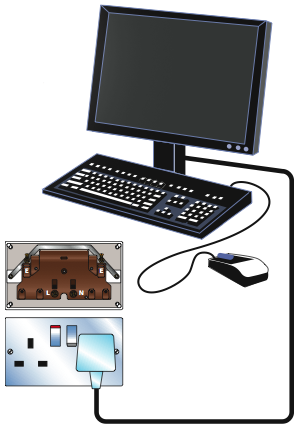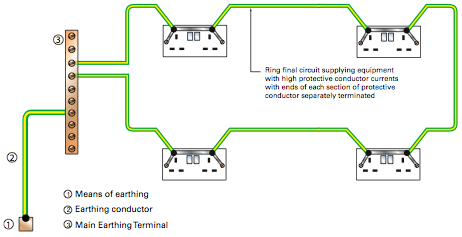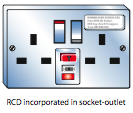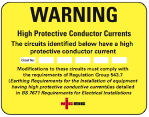When energised and in normal use, electronic items such as computers can cause current to flow in the circuit protective conductors (protective conductor current) which may, should the protective conductor become disconnected, present a risk of electric shock.


As a result, where a ring final circuit is intended to supply IT equipment, and it is expected, due to the number of items intended to be connected, that the protective conductor current is likely to exceed 10 mA, specific precautions need to be employed in accordance with BS 7671.
Accessories
A ring final circuit, by its particular configuration, provides duplication of the protective conductor and, provided the requirements of Section 543 are met, a high integrity protective conductor connection exists. However, for the requirements of Regulation Group 543.7 to be met, the ends of each section of protective conductor in the ring must be separately terminated. Socket-outlets and accessories such as connection units must be provided with two separate earth terminals (Regulation 543.7.1.204 refers).

Labelling
Where a circuit has or is likely to have a high protective conductor current, the protective conductor connection arrangements at the distribution board or consumer unit will, in many cases, be affected. For example, there will in some cases be duplicate protective conductors separately terminated. At the distribution board, a suitable warning sign and/or notice must be provided indicating those circuits having a high protective conductor current, and be so positioned as to be visible to a person modifying or extending the circuit (Regulation 543.7.1.205 refers).
RCDs
An RCD must be so selected and the circuits so subdivided that any protective conductor current expected to occur during normal operation of the connected load(s) will be unlikely to cause unnecessary tripping of the device (Regulation 531.2.4 refers).
As a rule of thumb, the designer should take care that the anticipated total protective conductor current does not exceed 25% of the rated residual operating current of the RCD. Where, for example, several items of equipment producing protective conductor current are to be supplied, it may be necessary to provide a number of separate RCD-protected circuits, each designed to supply a limited number of items appropriate to their protective conductor current. Therefore, to comply with the requirements of Regulation 411.3.3, relating to RCD protection of socket- outlets, and minimise the risk of unwanted tripping of RCDs the designer may need to consider:
- Providing more ring final circuits, each supplying a smaller number of socket-outlets.
- Providing socket-outlets individually protected by an RCD (SRCDs). Such a solution would require SRCDs with two earthing terminals for the duplicated protective conductor connections and may prove expensive for larger installations.


For other guidance and publications please see the NICEIC website.
For information about the NICEIC Approved Contractor or Domestic Installers schemes,visit www.niceic.com or call 0870 013 0382
